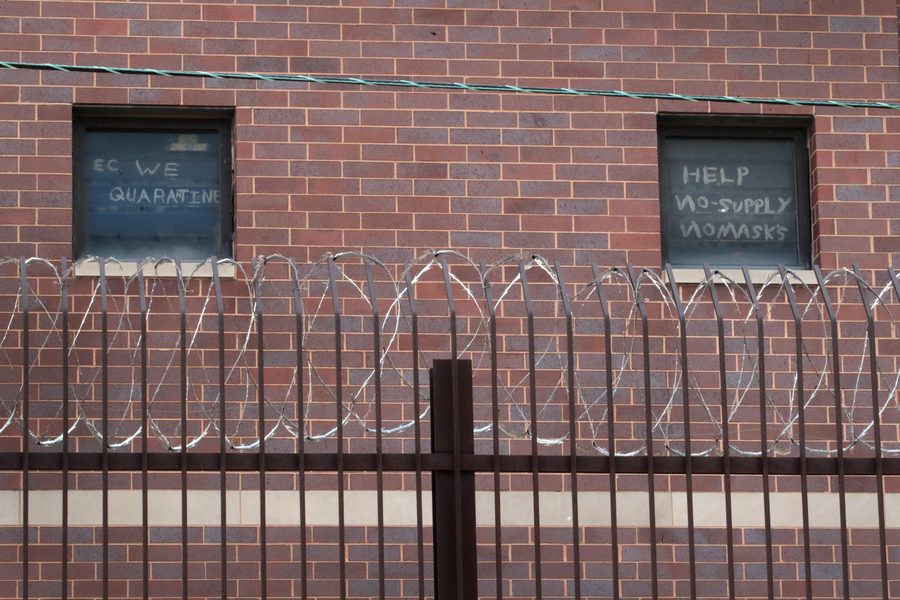They Are Burying Us Alive in Prison
When Covid-19 broke out in Stateville Correctional Center, we were left to die.
Raul Dorado

There are many ways to come to prison. You could have been raised in a segregated high-rise ghetto, removed from mainstream society and cut off from participation in the legal economy. Or you could just have been born black. If you inhabit a black body, you’re nearly six times more likely than whites to be imprisoned, and if you reside in a brown body, you’re three times more likely to be imprisoned. Covid-19 came to Stateville, undetected, in the bodies of the prison guards who have direct custody of us.
Prisons are long-term care facilities, but without the actual care. Just over four decades ago, Illinois fell in line behind a national trend to abandon the goal of rehabilitation in favor of punitive sentencing practices. These practices lay the foundation of today’s overcrowded prisons that have not spared the elderly prisoner population bearing the brunt of Covid-19.
When parole was abolished in 1978, any incentive for good behavior and self-rehabilitation was also eliminated. The message was clear: Despite your best efforts, you cannot earn early release. This message was reinforced with harsh sentencing laws designed to lock us in: Life without parole (LWOP), three strikes law, mandatory minimums, various sentence enhancements, and a Truth-In-Sentencing (TIS) law that by itself doubled the amount of time that people had to serve in prison.
There was no public outcry over TIS. Instead, the federal government induced the states to enact TIS legislation with the promise of jobs and funds to build new prisons. The federal government promised to fund the warehousing of human beings who everyone knew would most certainly be people of color.
Hawkish politicians leveraged this as an opportunity. Even as crime rates were decreasing, they fanned the flames of fear and sold the public on TIS while simultaneously catapulting themselves into office with tough-on-crime propaganda. Of course, the federal government lied and defaulted on their promise to pay for it all. Illinois taxpayers were stuck with the bill and people of color were crammed into cells.
When Covid-19 broke out in Stateville Correctional Center, where I am incarcerated, prison administrators and medical staff failed to adequately respond and 20 of our friends and neighbors lost their life. Prison administrators underestimated the danger, failed to create space to isolate individuals, failed to acquire and provide personal protective equipment and other medical supplies, and failed to provide us with basic hygiene and sanitation products. When our friends fell unresponsive, we had to yell at the top of our lungs for help. Our neighbors were carried out on stretchers and just a few hours later were returned back to their cells barely able to walk under their own power. Our friends were like fish out of water gasping for air and some died the very next day. It took someone dying for the Medical Examiner to finally start sending people out to the emergency room.
By now, everyone has heard the statistics recited about the racial disparities of who we incarcerate, but everyone is less acquainted with the people actually serving extreme sentences and with the individuals who died in the custody of the Illinois Department of Corrections due to Covid-19 and its accomplice: indifference. That’s how dehumanization works: Denying us the full portion of our humanity allows those in power to anesthetize themselves from the fact that a real person just died. They can bulldoze a mound of dirt over us and bury us alive in these massive tombs. But we know that allowing someone to die is subject to the same moral appraisal as killing someone. Indifference shares a bed with intent, and they both soil the linens just the same.
To some degree we are all broken like the glass on storefront windows and the best years of our lives have been looted. Those who continuously dehumanize us could only identify the sharp edges of our brokenness.
Most lawmakers responsible for plundering the supply of black and brown youth from our communities are no longer in office. And while many of our current legislators are willing to acknowledge the harms of mass incarceration, most are unwilling to expend the political capital to return us to our communities and reunite us with our loved ones. Not only do they fear being smeared as soft-on-crime, but they also fear political reprisals from the prison guards’ union that profits from our imprisonment.
Pinned under the knee of this injustice, we feel the weight of indifference bearing down on us. We collectively suffer the trauma of asphyxiation and we can’t breathe! There is no safety from moral appraisal on the sidelines: You either help or you let us die!
I am co-founder of Parole Illinois, an inside-outside prison project addressing the effects of long-term incarceration. Our group is supporting a bill in the Illinois legislature, SB3233: Earned Discretionary Release, which would address the needs of every category of incarcerated people. Any EDR legislation must be retroactive to include the people who for decades have shouldered the burden of mass incarceration. I would like to give credit where credit is due and praise Governor J.B. Pritzker for courageously using his power of Executive Clemency to grant sentence commutations. There is still urgency to passing legislation that gives a second chance to others in our overcrowded prison system. Legislators can act now to save lives.
A version of the above statement was delivered by Raúl Dorado at “A People’s Tribunal: COVID-19 and the Crisis of Death by Incarceration,” a Zoom webinar that took place June 4, 2020. The event was organized by a coalition of groups led by Parole Illinois.




